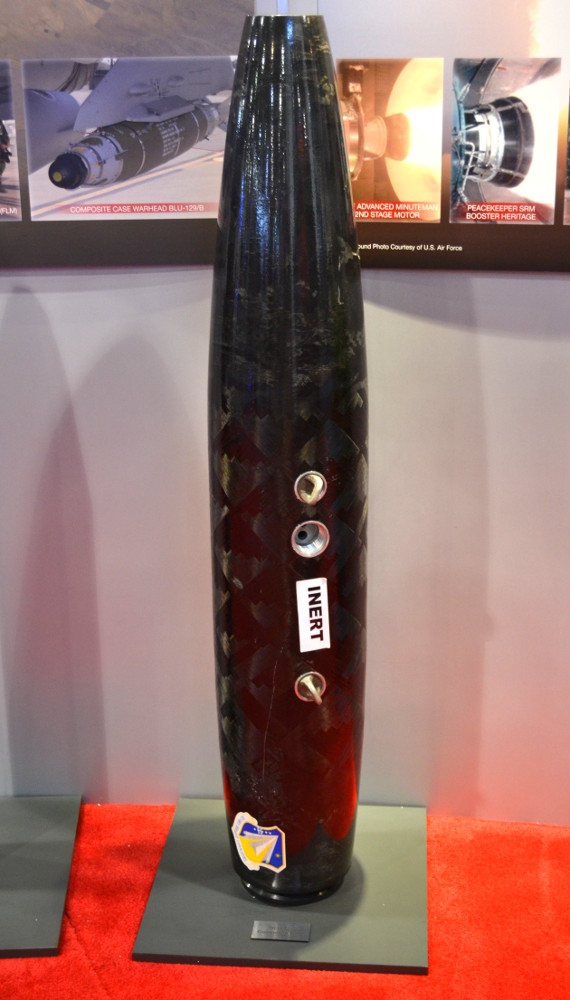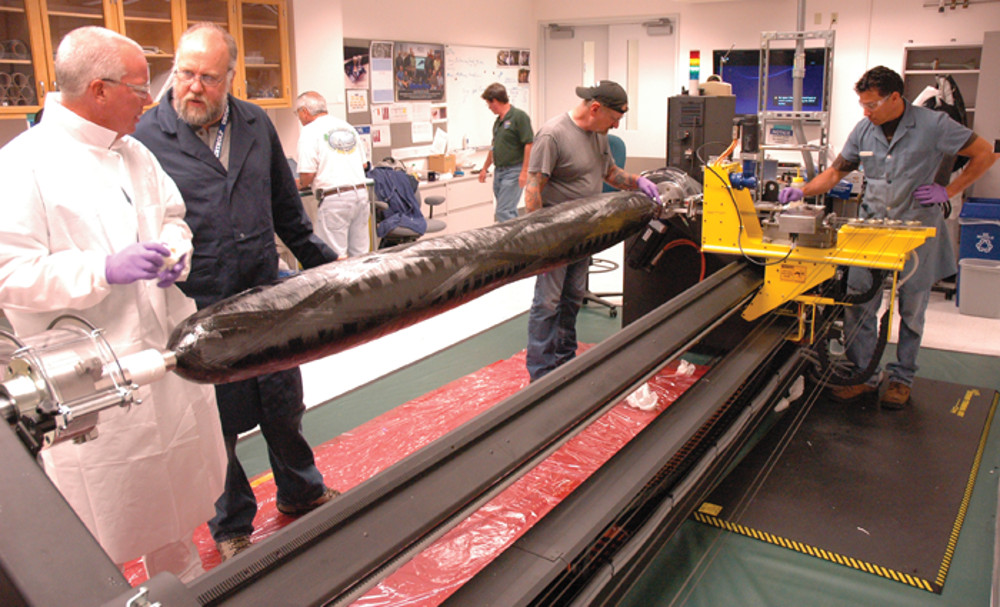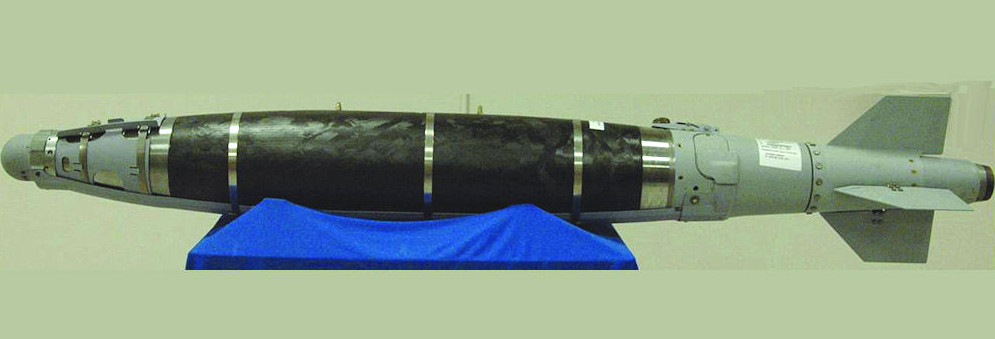For the third year in a row, the U.S. Air Force is asking for funds to buy a small number of bombs with special carbon fiber shells that make them less likely to endanger friendly forces, cause collateral damage, and accidentally kill civilians. It’s an increasingly important tool for the service to have, but it has yet to start buying them in bulk, likely in part because they’re amazingly expensive.
In the Air Force’s latest budget request for the 2019 fiscal year, which it released earlier in February 2018, the service asked for a little more than $8 million to buy just 70 of the 500-pound class carbon fiber BLU-129/Bs, also known as the Very Low Collateral Damage Weapon, or VLCDW. At that price, each one costs more than $116,000, or at least 40 times more than the regular 500-pound class BLU-111/B high explosive bomb and more than five times the cost of even the service’s new 2,000-pound class BLU-137/B bunker buster. This figure doesn’t include the cost of precision guidance kits or specialized fuzes either.
In spite of that price tag, the basic concept behind the weapon is relatively simple. When the bomb explodes, the carbon fiber body vaporizes, producing no shrapnel that might end up flying far away from the point of detonation, injuring innocent civilians or unnecessarily damaging private property.
This is effectively the opposite of the Air Force’s new cast ductile iron bombs, which have their own special shell that is supposed to fragment uniformly for maximum damage across a broad area. Those weapons are supposed to offer a safer alternative to cluster bombs, leaving no unexploded bomblets behind, but would still be quite threatening to anyone caught in its wide blast radius.

Precision guidance can help reduce unintended damage, too, but it doesn’t do anything to limit the effects of a weapon once it explodes. According to the Air Force’s budget documents, the weapon is three times less likely than a standard 500-pound class high explosive bomb to cause damage to anything but the intended target. It’s also a significant improvement over the previous BLU-126/B Low Collateral Damage Bomb, or LCDB, which was simply a regular steel cased BLU-111/B, but with less explosive filler.
The Air Force fields the bomb in just one configuration, combined with a Joint Direct Attack Munition (JDAM) GPS-guidance kit and the service refers to the complete system as the GBU-38(V)5/B. Ground crews will often assemble the weapons with air burst fuzes with DSU-33/B proximity sensor, which detonate the bomb at a preset height above the ground. Since its not designed to penetrate reinforced materials or create a cloud of deadly shrapnel, in any configuration, the bomb’s blast radius is relatively contained, making it less useful against hardened targets or enemy forces spread out across a wide area.
But the weapons are ideal for engaging hostile forces situated dangerously close to friendly troops or innocent civilians, especially those who are either entirely exposed or have no overhead cover. They’re particularly useful for operations in dense urban environments and the Air Force has already employed them against ISIS in Iraq and Syria and against the Taliban and other militants in Afghanistan.
The Air Force, as well as other U.S. military services, have also been developing
smaller guided munitions that allow for more precision targeting with less risk to nearby friendly forces or civilians. Of course, by virtue of their size, those weapons also generally lack the destructive power of larger bombs. Depending on the exact situation, a weapon such as the BLU-129/B might offer a sorely needed compromise when targeting specific terrorists or small groups of militants.
The bombs are also apparently a feat of engineering and materials science that the Air Force crafted together the Lawrence Livermore National Laboratory (LLNL), a Department of Energy research center better known for designing nuclear weapons. Since 1985, Energy has had a formal relationship with the Department of Defense to make those same resources available for conventional weapons development.

And while carbon fiber is a well understood materiel, the scientists and engineers who developed the BLU-129/B had to craft a complex shell that was rigid enough to survive flying attached to a fast moving combat aircraft, falling thousands of feet, and then potentially breaking through a barrier such as the roof of a typical building, but would still produce no fragments when the bomb exploded. A special multiphase blast (MBX) explosive filler helps ensure that the casing disintegrates completely.
To help speed up the project, which began in 2010, personnel at LLNL heavily utilized supercomputer-powered models and simulations to determine how the bomb’s case would react to various stresses in order to determine whether it would function properly. According to an article in the March 2013 issue of laboratory’s internal Science & Technology Review magazine, scientists and engineers did 95 percent of the design work through modeling rather than physical testing and prototyping.
“In the ‘old’ days, we would build a prototype, test it, and revamp it based on the results,” Kip Hamilton, the project manager for the bomb at LLNL said in an interview for article. “Our advanced modeling and simulation capabilities reduce the time needed to determine the final design specifications for munitions.”
LLNL also said it designed the prototype weapons from the beginning with an eye toward mass production. Unfortunately, after the better part of a decade and despite the weapon’s obvious utility, this still hasn’t happened.

In each budget request since the 2016 fiscal year, the Air Force has asked for the same amount, a little more than $8 million, to buy 70 of the bombs. In January 2017, the service cut a one-time fixed-price deal with General Dynamics Ordnance and Tactical Systems to build up to 500 of the carbon fiber bodies over an indefinite period.
According to the latest budget request for fiscal year 2019, the Air Force is still trying to determine how many BLU-129/Bs it should keep on hand at any one time in general. In the meantime, it says it is only buying just enough to meet stated operational demands.
One has to wonder whether the limited stockpile of the weapons to begin with, combined with their exorbitant cost, might make units flying missions over Iraq and Syria and Afghanistan less likely to use them or ask for more, though, even when they might be useful. The fight against ISIS in Iraq and Syria, in particular, involved major aerial campaigns over cities, such as the terrorist group’s de facto capital in the Syrian city of Raqqa, where the carbon fiber bombs might have helped mitigate the reportedly significant numbers of civilian casualties.
Inversely, it is possible that there might be more demand if there were more of the bombs available. Larger purchases would likely help drive down the high unit price, at least to some degree, as well.
The video below shows a U.S.-led coalition air strike on a building in Raqqa, Syria in 2015, which gives a good sense of the effects of using standard high explosive bombs in an urban environment.

“The way wars are fought now is vastly different than it was even 15 years ago,” Hamilton said in 2013. “More consideration is given to protecting warfighters in close proximity to targets and to civilians not engaged in the fight.”
These statements have only become more pronounced since then in an age of cell phone cameras and the internet. Any errant shrapnel can quickly become a major propaganda tool and give ammunition to both actual enemy forces, as well as other critics, including opposing governments elsewhere in the world.
Battles inside built up areas full of both enemy forces and regular people caught up in the fighting are also likely to become increasingly more common as time goes on and as global populations grow and urbanization expands around the world. The Pentagon as a whole is increasingly becoming more concerned by the prospect of future conflicts that take place in part inside “megacities,” which it defines as cohesive population centers with 10 million or more inhabitants.
Though they’re unlikely to ever replace all bombs in all situations, having options like the BLU-129/B, or a cheaper, more usable alternative, will be an important capability for the Air Force going forward. Hopefully, they’ll be able to find a way to bring the costs down and do so quickly.
Contact the author: joe@thedrive.com
